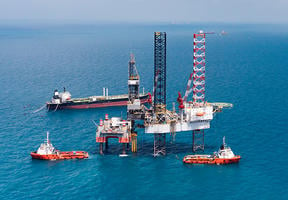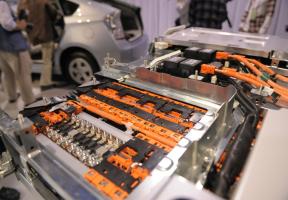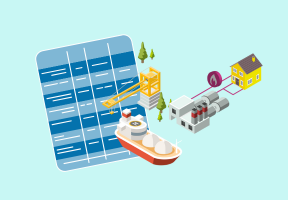
1. The quest for greener motor vehicles
Electric vehicles represent a shift toward modes of transportation that are less dependent on petroleum-based and emit less greenhouse gas. While sales have soared, estimates still only put the number of electric vehicles on the road in 2020 at around 7 million – well below 1% of all vehicles worldwide – and their environmental performance depends on how their is produced.

2. Hydrogen fuel cell vehicles
Korean and Japanese manufacturers are the first to have sold vehicles in their thousands, but all major carmakers are now testing their own prototypes. Pressurized hydrogen is used to charge the fuel cells, which generate electricity to the engine. Below, the insides of the Toyota Mirai are exhibited at a car show in Tokyo in December 2015.

3. Trams make a comeback
Trams began transporting passengers in the 19th century, but virtually disappeared in the 1950s due to the rise of buses and subways. Over the past 25 years, this mode of transportation has been revived in the densely populated towns and cities of both developed nations and emerging economies (below, a tram being tested in Medellin, Colombia in late 2015). Tram networks operate at a high frequency and are three times less expensive to build than a metro system, making them an attractive transportation solution.

4. Cable cars descend from mountain to city
Typically found in mountain resorts, cable cars are making their way to cities across the world and becoming an everyday mode of transportation. In Rio de Janeiro, they are seen as a way of opening up the city to favela residents. Below, 155 of these 8-seater cabins carry 30,000 passengers a day over the Alemao favela, home to 100,000 people.

5. Trucks could run on electricity too
While the concept may sound unusual, it is undergoing major testing by Siemens in Germany and the United States. Below, a truck fitted with catenaries drives along a highway with an overhead line in eastern Germany. The electricity in the overhead line charges the truck's batteries, thereby powering its electric engine. Similar tests are being conducted at the Port of Los Angeles in California.

6. Energy generated by solar-powered roadways
Engineers in several countries are testing road surfaces with built-in photovoltaic cells capable of generating electricity for local use. In March 2016, France’s minister unveiled a solar-powered road panel prototype in Marseille (photo). While the results are still not very convincing, Colas, the French company behind the innovation, is continuing tests.

7. A train that can reach speeds of 1,200 km/h
Hard to imagine such a train of the future by looking at the photo. However, this sled, which was demonstrated near Las Vegas, is an early prototype of the Hyperloop train that would enable passengers to travel the 600 km from Los Angeles to San Francisco in 30 minutes by the early 2020s. Thanks to the use of air cushions produced in reduced-pressure tubes, passengers shouldn't feel the effects of acceleration any more than if they were in an aircraft during take-off. Several companies (Hyperloop One in this case) are working on the project launched by the American billionaire Elon Musk.

8. The return of airships
On May 6, 1937, the Hindenburg disaster marked the end of passenger airship travel. The LZ 129 was built by the German company Zeppelin and carried passengers between Europe and the United States. Today, a British company is hoping to launch Airlander 10, a new model of airship (photo). Although its first test flight in August 2016 did not go entirely to plan, its promoters remain optimistic. The aircraft would be capable of carrying 50 metric tons of freight at a low cost and with next to no CO2 emissions.

9. Small electric aircraft
A number of aircraft manufacturers are working on electric planes powered by batteries that are charged mainly on the ground. Given the batteries' weight and range, the aircraft need to be extremely light and able to glide (photo, the Pipistrel Taurus). The well-known Solar Impulse plane, however, goes a step further, producing all of its electricity via wing-based solar panels.

10. Bicycles back in fashion in developed countries
While people in emerging economies dream of cars and scooters, developed countries are encouraging the resurgence of bicycle travel. First there were on-road bike lanes, now we are seeing the rise of fully segregated bike highways. Below, a 5km stretch of "bike autobahn" is being trialed in Mulheim, Germany. The route should eventually cover up to 100km, connecting ten cities in the Ruhr region, and will run on disused railway tracks.

11. As well as new methods, a shift in habits
In order to reduce the use of cars, cities are increasingly seeking to encourage new forms of sharing over individual ownership. In summer 2007, Paris introduced a bike-sharing scheme known as Velib'. The idea inspired a large number of cities across the world to follow suit. Below, 350 Citi Bikes were introduced in New York with the support of popular local baseball team the Mets.

12. First bicycles and cars, now scooters
Car-sharing services in Paris (Autolib’ from 2011 to 2018, then Mobilib’) enable users to pick up or drop off a vehicle at one of more than 1,000 stations. After a year of testing, in June 2016 the city also rolled out CityScoot all-electric scooters (photo). Speed is limited to 45km/h and the service is only available during the day. A 30-minute trip across Paris costs around €9.

13. International ridesharing schemes
Since its launch in France by Frederic Mazella (photo), the concept of a fee-based car-sharing community has met with worldwide success. BlaBlaCar connects drivers and passengers traveling the same way – often across borders – and is much cheaper than trains and planes. The platform operates in 22 countries, mainly in Europe, Turkey, Mexico, India and Brazil, and in 2015 it had 20 million members.

14. A more efficient commute
Ridesharing is also used at a local level between people with similar daily commutes. The French Environment and Energy Management Agency, ADEME, has observed a link between local ridesharing and higher fuel prices. Around three million French people rideshare on a regular basis.

15. The quest for the highest tech
As is often the case in the automotive industry, high-level motorsports are an opportunity to test new technologies and materials. We're not talking about Formula 1, but Formula E (for "electric"). Championships are staged across the globe in places such as Beijing, London and Paris (below, in front of the Hôtel des Invalides). The cars can reach 100km/h in three seconds, but must be fitted with 200kg batteries which offer a range of just 20 minutes.

16. An immensely diverse world
Transportation depends not only on technology and innovation, but also greatly on a country's level of development, the availability of public transportation, and tradition. In Karachi, Pakistan, a father has adapted his motorbike himself to create the most efficient way possible of transporting his children (below).
 Our most popular content
Our most popular content
See all






















